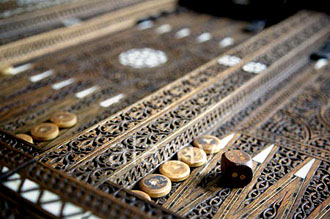|
| Magriel's NYT Columns |
 The Metropolitan Backgammon Open, sponsored by the International Backgammon Association, took place last weekend in New York City.
James Pasko, one of New Jersey’s best players, defeated Len Borman of Detroit to take first place in the championship division; Al Hodis and Ken Cohen were semifinalists.
The Metropolitan Backgammon Open, sponsored by the International Backgammon Association, took place last weekend in New York City.
James Pasko, one of New Jersey’s best players, defeated Len Borman of Detroit to take first place in the championship division; Al Hodis and Ken Cohen were semifinalists.
In other sections: Stanley Friedenberg overcame Mel Leifer in the consolation; Al Martorano beat Sybil Appel for the intermediate; Marco Hoffman and Francis Goldfarb teamed up to win the doubles.
Pasko (Black) had a crucial decision to make in the diagrammed position, taken from his 15-point finals match against Borman (White). With the score tied at double match point, this was the last and deciding game.
|
14
MATCH TO 15 14 |
| Black to play 6-4. |
Black must first consider the danger involved in running immediately and so leaving a single man back on the 20-point. White, being slightly behind in the race, would naturally be eager to attack this lone man. Because of White’s exposed man on the 23-point, Black can be sure of some chance to retaliate if White attacks.
Nevertheless, the risk for Black is still unacceptably high. White has 10 combinations (out of 36 possible) that both hit Black and make the 20-point. Furthermore, even if White fails to point on Black he will at least be able to cover his blot on the 23-point. Black may then have trouble running his back man home safely.
Pasko (Black) correctly chose a more conservative waiting play, 13/7, 13/9, bringing down his two men from the mid-point (13-point). By waiting, he could expect an indirect 8-shot at White when White gives up the 12-point. Furthermore, he would have several chances to roll a big double and escape without any danger at all. In fact, two rolls later, Pasco threw 5-5, ran, and easily won the race.
Rollout
 Tom Keith 2013 |
|
Match to 15 White 14, Black 14 Black rolls 6-4 1296 games with VR Checker play: 2-ply Cube play: 3-ply Red |
| 6-4: | Game | G | BG | Equity | ||||
| 1 | 20/16, 20/14 |
W L |
.4688 .5312 |
.0300 .0236 |
.0001 .0006 | −0.0624 |

| |
| 2 | 13/9, 13/7 |
W L |
.4270 .5730 |
.0204 .0213 |
.0001 .0004 | −0.1461 | (0.0837) | (b) |
| 3 | 20/10 |
W L |
.4125 .5875 |
.0296 .0286 |
.0003 .0012 | −0.1751 | (0.1127) | (a) |

|
|

